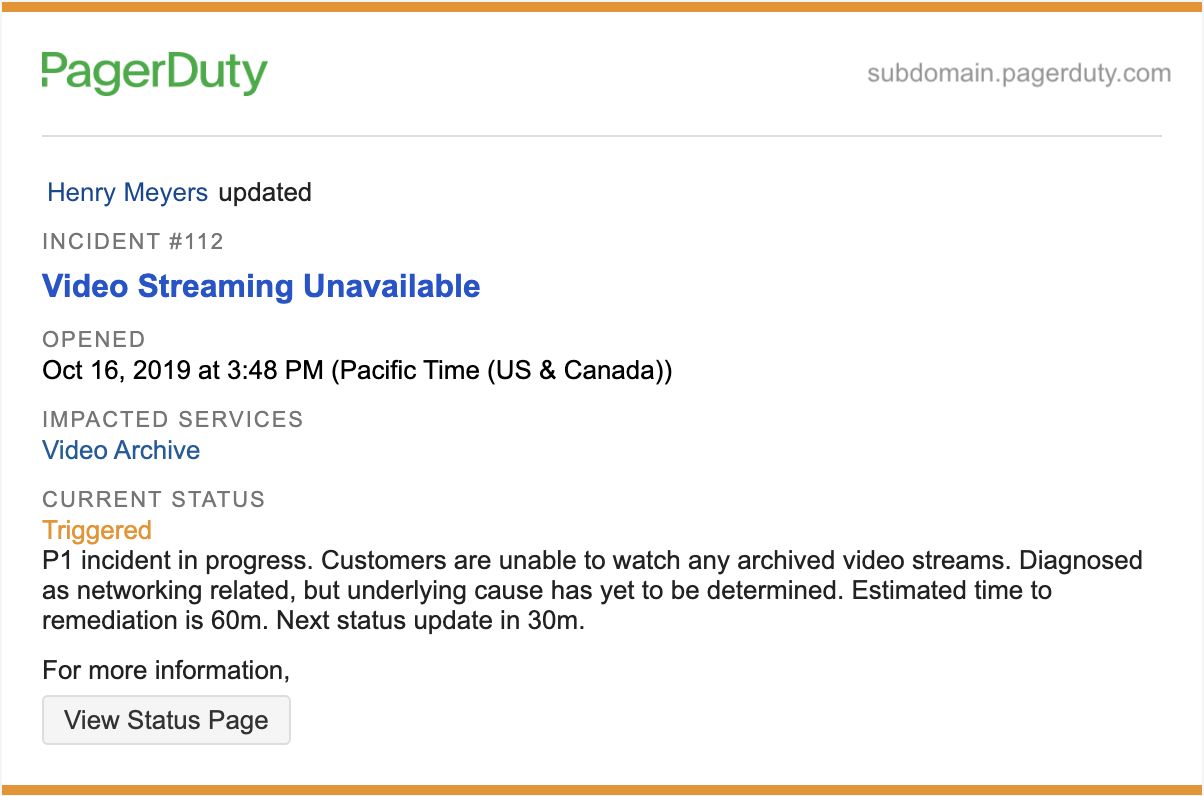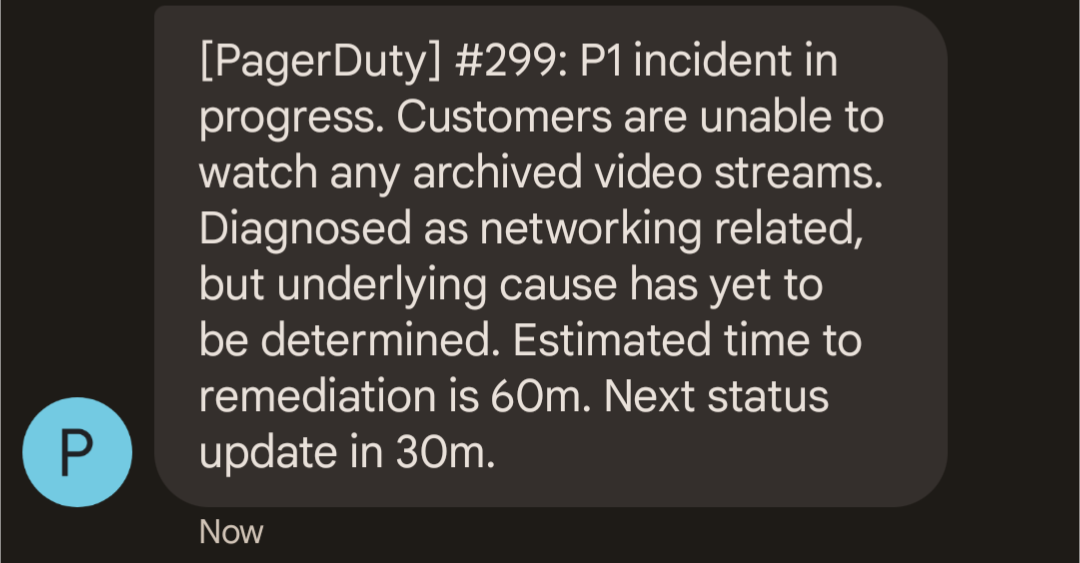Communicate with Stakeholders
Provide stakeholders with proactive information about an incident's scope of impact and progress towards resolution
Proactive stakeholder communications advise others on an incident’s status and scope of impact. When stakeholders receive proactive status updates, the primary response team can focus on resolution, rather than answering status inquiries, leading to more efficient incident response and improved mean-time-to-resolve (MTTR).
Pricing Plan Availability
This feature is available to customers on our Business, Enterprise for Incident Management and Digital Operations (Legacy) plans. Please contact our Sales Team if you would like to upgrade to a plan with this feature.
Add Subscribers to an Incident
PagerDuty offers multiple ways to add subscribers to incidents:
- Add subscribers to an ongoing incident
- Add subscribers at incident creation
- Subscribe to a business service
Stakeholder Users
Any kind of PagerDuty user can be added as an incident subscriber: the account owner, managers, responders, etc. There are also special Full Stakeholder and Limited Stakeholder user licenses available; these user roles are specifically designed to subscribe to incidents and receive incident status updates. Full Stakeholders have read-only access to other data in your PagerDuty account, while Limited Stakeholders only have access to view and subscribe to the status dashboard, and do not see any other parts of PagerDuty. Full Stakeholders and Limited Stakeholders cannot add, edit or delete any objects in the account. Both Stakeholder user licenses are available at a reduced price and are ideal for employees that need to be involved in internal incident communications but do not actively participate in the resolution effort. Please contact our Sales Team for more information about both types of Stakeholder users.
Add Subscribers to an Ongoing Incident
Users and Teams can be subscribed to an active incident from the PagerDuty web app or the mobile app.
Unsubscribed Users
If an individual user has already subscribed to an incident and then unsubscribes from it, you will not be able to resubscribe them as part of a Team or as a group via Incident Workflow. You must either resubscribe them as an individual user using instructions below, or the user must resubscribe themselves.
Add Subscribers to an Ongoing Incident in the Web App
- On the Incidents page, select an incident to go to its detail page.
- Select the Status Updates tab Manage Subscribers.
- On the Manage Subscribers screen, search for and select users and Teams to subscribe to the incident.
- Click Add Subscribers.
Add Subscribers to an Ongoing Incident in the Mobile App
- On the Incidents screen, select an incident to go to its detail view.
- Select the Overview tab scroll to the section Latest Status Update tap Manage.
- On the Subscribers screen, tap in the top-right, then search or select users or Teams to subscribe to the incident. Users and Teams are automatically subscribed as soon as you tap them.
Add Subscribers at Incident Creation
You can configure PagerDuty to automatically subscribe stakeholders whenever an incident triggers. You can subscribe up to 25,000 users to an incident.
To automatically subscribe users:
-
Create an Incident Workflow that subscribes users and/or Teams. If you frequently subscribe the same sets of stakeholders to incidents, you can simplify this task by adding those groups to the Incident Workflow.
-
Associate the Incident Workflow with a PagerDuty service under the Services that this rule applies to section in the Workflow.
Note
Stakeholders do not receive a notification when they are subscribed to an incident. This “silent subscription” allows you to subscribe stakeholders to an incident at any time (for example, at incident creation) and then explicitly choose to publish a status update if there is something noteworthy to report. Thus, stakeholders only receive curated updates, which helps avoid notification fatigue.
Subscribe to a Business Service
Users that subscribe to a business service will be added as a subscriber whenever there is an incident that affects the business service. To learn more about subscribing to a business service, please refer to Business Service Subscription.
Remove Subscribers from an Incident
Users assigned to an incident can remove subscribers from an incident, and subscribers can choose to unsubscribe themselves.
Remove a Subscriber in the Web App
- Navigate to Incidents and select an incident’s Title to view its detail page.
- Select the Status Updates tab Manage Subscribers.
- In the list of Subscribers, find the user or Team you wish to unsubscribe and click Unsubscribe on the right.

Unsubscribe a user from an incident
Remove a Subscriber in the Mobile App
- On the Incidents screen, select an incident to go to its Incident Details screen.
- Select the Overview tab scroll to the section Latest Status Update tap Manage.
- Next to the subscriber's name, tap Unsubscribe.
Status Updates
Once subscribed to an incident, stakeholders can expect to receive all subsequent status updates on that incident. Status updates can be sent five different ways:
- A responder can compose and publish an ad-hoc status update via the web or mobile app.
- A responder can send incident resolution notes as a status update.
- A responder can send status updates with rich text email notifications.
- A responder can send status updates as part of an Incident Workflow.
- A responder can send a status update or start an Incident Workflow Instance that sends a predefined message via the API.
Required User Permissions
- All users, with the exception of Limited and Full Stakeholders, can send status updates for incidents assigned to them.
- Only Responders, Managers, Global Admins and Account Owners can send status updates for incidents that are not assigned to them.
Send Status Updates via Web or Mobile App
Publishing an ad-hoc status update in the web or mobile app is beneficial when the update is context-dependent. For example, if a status update needs to provide details about the nature of the incident, the current impact or the estimated resolution time, for example:
P1 incident in progress. Customers are unable to watch any archived video streams. Diagnosed as networking-related, but underlying cause is still being determined. Estimated time to remediation is at least 60m. Next status update in 30m.
Send Status Updates via the Web App
- Navigate to the Incidents page and click an incident’s Title to view the detail page.
- Select the Status Updates tab.
- Enter or confirm the Impacted Business Service and click New Update in the Status Updates section.
- Enter your Message for the status update.
- Click Send Update.
Select a Business Service
If you see a message that “This update will not be published to your status dashboard,” make sure you’ve selected a business service in step 3, above.
Send Status Updates via the Mobile App
- Navigate to the Incidents screen and select an incident to go to its detail screen.
- Select the Overview tab, scroll to the Latest Status Update section and then tap Post Status Update.
- On the Add Status Update screen, enter your status update message.
- Tap in the upper right to send the status update.
Select a Business Service
If you see a message “Update will not be shown on the status dashboard,” it is most likely because a business service is not selected or the incident does not have a priority.
Select a Business Service in the Mobile App
- Navigate to the Incidents page in the mobile app and tap the Title of an active incident to view the incident details page.
- Select the Overview scroll to the section Latest Status Update tap Post Status Update.
- On the Add Status Update screen, tap Change.
- In the section Impacted Business Services, tap .
- On the Add Business Service screen, select a business service.
- Tap Done.
Edit Incident Priority in the Mobile App
- Navigate to the Incidents page in the mobile app and tap the Title of an active incident to view the incident details page.
- Select the Overview scroll to the section Latest Status Update tap Post Status Update.
- On the Add Status Update screen, tap Change.
- In the section Incident Priority, tap .
- On the Edit Priority screen, select a priority business service and tap Confirm in the confirmation modal.
- Tap Done.
Send Status Update via Incident Workflows
You can send Status Updates as part of an Incident Workflow. Please read Incident Workflows for more information.
Send Resolution Notes as a Status Update
When resolving an incident, responders have the option to add a resolution note. This note can also be sent to subscribers as a status update if:
- The incident has subscribers OR the incident is visible on the status dashboard
- AND the incident is resolved from the PagerDuty web app as a single resolve (versus a bulk resolve from the incident dashboard)

Incident resolution note
By checking the box Post resolution note as status update, the note will be sent to all subscribers on the incident, regardless of whether they were added via Incident Workflow or added on demand through the UI.
Send Status Updates via API
Follow our API documentation to publish a status update or start an Incident Workflow Instance that publishes a predefined message via the API.
Status Update Templates
Please read our Status Update Templates article for more information on customizing and standardizing your status updates.
Status Update Notification Methods
By default, status updates will be sent to subscribed users depending on the status update notification rules they have configured on their user profile. It is not currently possible to configure a time delay for status update notifications. For information about configuring status update notifications, please see Status Update Notifications.
Email Status Update
Status update emails contain the most information about an incident:
- Who sent the status update
- Incident number and description
- When the incident was opened
- The affected service
- Incident status
- A link to the incident status page

Email Status Update
SMS Status Update

SMS Status Update
Push Status Update

Push Notification Status Update
Status Dashboard Update
In addition to the notification methods above, all status updates will also be posted to the status dashboard. For more information on how to show an incident on the status dashboard, see Status Updates.

Status Dashboard Update
Updated about 1 month ago
